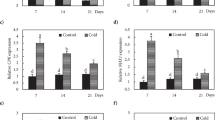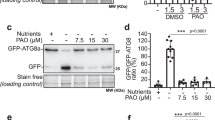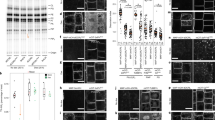Abstract
Freezing injury is a major environmental limitation on the productivity and geographical distribution of plants. Here we show that freezing tolerance can be manipulated in Arabidopsis thaliana by genetic alteration of the gene encoding phospholipase Dδ (PLDδ), which is involved in membrane lipid hydrolysis and cell signaling. Genetic knockout of the plasma membrane–associated PLDδ rendered A. thaliana plants more sensitive to freezing, whereas overexpression of PLDδ increased freezing tolerance. Lipid profiling revealed that PLDδ contributed approximately 20% of the phosphatidic acid produced in wild-type plants during freezing, and overexpression of PLDδ increased the production of phosphatidic acid species. The PLDδ alterations did not affect the expression of the cold-regulated genes COR47 or COR78 or alter cold-induced increases in proline or soluble sugars, suggesting that the PLD pathway is a unique determinant of the response to freezing and may present opportunities for improving plant freezing tolerance.
This is a preview of subscription content, access via your institution
Access options
Subscribe to this journal
Receive 12 print issues and online access
$209.00 per year
only $17.42 per issue
Buy this article
- Purchase on Springer Link
- Instant access to full article PDF
Prices may be subject to local taxes which are calculated during checkout






Similar content being viewed by others
References
Thomashow, M.F. Plant cold acclimation: freezing tolerance genes and regulatory mechanisms. Annu. Rev. Plant Physiol. Plant Mol. Biol. 50, 571–599 (1999).
Iba, K. Acclimative response to temperature stress in higher plants: approaches of gene engineering for temperature tolerance. Annu. Rev. Plant Biol. 53, 225–245 (2002).
Gong, Z. et al. RNA helicase-like protein as an early regulator of transcription factors for plant chilling and freezing tolerance. Proc. Natl. Acad. Sci. USA 99, 11507–11512 (2002).
Chinnusamy, V. et al. ICE1: a regulator of cold-induced transcriptome and freezing tolerance in Arabidopsis. Genes Dev. 17, 1043–1054 (2003).
Jaglo-Ottosen, K.R., Gilmour, S.J., Zarka, D.G., Schabenberger, O. & Thomashow, M.F. Arabidopsis CBF1 overexpression induces COR genes and enhances freezing tolerance. Science 280, 104–106 (1998).
Kasuga, M., Liu, Q., Miura, S., Yamaguchi-Shinozaki, K. & Shinozaki, K. Improving plant drought, salt, and freezing tolerance by gene transfer of a single stress-inducible transcription factor. Nat. Biotechnol. 17, 287–291 (1999).
Xin, Z. & Browse, J. eskimo1 mutants of Arabidopsis are constitutively freezing-tolerant. Proc. Natl. Acad. Sci. USA 95, 7799–7804 (1998).
Seki, M. et al. Monitoring the expression pattern of 1300 Arabidopsis genes under drought and cold stresses by using a full-length cDNA microarray. Plant Cell 13, 61–72 (2001).
Fowler, S. & Thomashow, M.F. Arabidopsis transcriptome profiling indicates that multiple regulatory pathways are activated during cold acclimation in addition to the CBF cold response pathway. Plant Cell 14, 1675–1690 (2002).
Thomashow, M.F. So what's new in the field of plant cold acclimation? Lots! Plant Physiol. 125, 89–93 (2001).
Knight. H., Trewavas, A.J. & Knight, M. Cold calcium signaling in Arabidopsis involves two cellular pools and a change in calcium signature after acclimation. Plant Cell 8, 489–503 (1996).
Plieth, C., Hansen, U.P., Knight, H. & Knight, M. Temperature sensing by plants: the primary characteristics of signal perception and calcium response. Plant J. 18, 491–497 (1999).
Ruelland, E., Cantrel, C., Gawer, M., Kader, J.C. & Zachowski, A. Activation of phospholipases C and D is an early response to a cold exposure in Arabidopsis suspension cells. Plant Physiol. 130, 999–1007 (2002).
Welti, R. et al. Profiling membrane lipids in plant stress responses. Role of phospholipase Dα in freezing-induced lipid changes in Arabidopsis. J. Biol. Chem. 277, 31994–32002 (2002).
Cullis, P.R. & DeKruijff, B. Lipid polymorphism and the functional roles of lipids in biological membranes. Biochim. Biophys. Acta 559, 399–420 (1979).
Verleij, A.J., DeMaagd, R., Leunissen-Bijvelt, J. & DeKruijff, B. Divalent cations and chlorpromazine can induce non-bilayer structures in phosphatidic acid-containing membranes. Biochim. Biophys. Acta 684, 255–262 (1982).
Wang, X. Phospholipase D in hormonal and stress signaling. Curr. Opin. Plant Biol. 5, 408–414 (2002).
Qin, C. & Wang, X. The Arabidopsis phospholipase D family. Characterization of a calcium-independent and phosphatidylcholine-selective PLDζ1 with distinct regulatory domains. Plant Physiol. 128, 1057–1068 (2002).
Wang, C. & Wang, X. A novel phospholipase D of Arabidopsis that is activated by oleic acid and associated with the plasma membrane. Plant Physiol. 127, 1102–1112 (2001).
Gardiner, J.C. et al. 90-kD phospholipase D from tobacco binds to microtubules and the plasma membrane. Plant Cell 13, 2143–2158 (2001).
Katagiri, T., Takahashi, S. & Shinozaki, K. Involvement of a novel Arabidopsis phospholipases D, AtPLD, in dehydration-inducible accumulation of phosphatidic acid in stress signaling. Plant J. 26, 595–605 (2001).
Zhang, W. et al. Phospholipase Dδ and phosphatidic acid decrease H2O2-induced cell death in Arabidopsis. Plant Cell 15, 2285–2295 (2003).
Prasad, T.K., Anderson, M.D., Martin, B.A. & Stewart, C.R. Evidence for chilling-induced oxidative stress in maize seedlings and a regulatory role for hydrogen peroxide. Plant Cell 6, 65–74 (1994).
Sakamoto, A., Valverde, R., Alia, R., Chen, T.H.H. & Murata, N. Transformation of Arabidopsis with the codA gene for choline oxidase enhances freezing tolerance of plants. Plant J. 22, 449–453 (2000).
McKersie, B.D., Bowley, S.R. & Jones, K.S. Winter survival of transgenic alfalfa overexpressing superoxide dismutase. Plant Physiol. 119, 839–848 (1999).
Dubouzet, J.G. et al. OsDREB genes in rice, Oryza sativa L., encode transcription activators that function in drought-, high-salt- and cold-responsive gene expression. Plant J. 33, 751–763 (2003).
Hardy, S., Langelier, Y. & Prentki, M. Oleate activates phosphatidylinositol 3-kinase and promotes proliferation and reduces apoptosis of MDA-MB-231 breast cancer cells, whereas palmitate has opposite effects. Cancer Res. 60, 6353–6358 (2000).
Kachroo, P., Shanklin, J., Shah, J., Whittle, E.J. & Klessig, D.F. A fatty acid desaturase modulates the activation of defense signaling pathways in plants. Proc. Natl. Acad. Sci. USA 98, 9448–9453 (2001).
Fan, L., Zheng, S. & Wang, X. Antisense suppression of phospholipase Dα retards abscisic acid- and ethylene- promoted senescence in postharvest Arabidopsis leaves. Plant Cell 9, 2183–2196 (1997).
Pappan, K., Zheng, S. & Wang, X. Identification and characterization of a novel phospholipase D that requires polyphosphoinositides and submicromolar calcium for activity in Arabidopsis. J. Biol. Chem. 272, 7048–7054 (1997).
Magne, C. & Larher, F. High sugar content of extracts interferes with colorimetric determination of amino acids and free proline. Anal. Biochem. 200, 115–118 (1992).
Bravo, L.A., Zúñiga, G.E., Alberdi, M. & Corcuera, L.J. The role of ABA in freezing tolerance and cold acclimation in barley. Physiol. Plant. 103, 17–23 (1998).
Acknowledgements
This work was supported by grants from the National Science Foundation (NSF), US Department of Agriculture, Kansas NSF EPSCoR and the Kansas State University Plant Biotechnology Center. The authors would like to thank Charles Rife for freezing chamber use, Todd Williams for acquisition of the ESI-MS/MS data and Christen Buseman for help with processing of the lipid profiling data. This is contribution 04-265-J from the Kansas Agricultural Experiment Station.
Author information
Authors and Affiliations
Corresponding author
Ethics declarations
Competing interests
The authors declare no competing financial interests.
Supplementary information
Rights and permissions
About this article
Cite this article
Li, W., Li, M., Zhang, W. et al. The plasma membrane–bound phospholipase Dδ enhances freezing tolerance in Arabidopsis thaliana. Nat Biotechnol 22, 427–433 (2004). https://doi.org/10.1038/nbt949
Received:
Accepted:
Published:
Issue Date:
DOI: https://doi.org/10.1038/nbt949
This article is cited by
-
Major-effect quantitative trait locus qLKR4.1 encodes a phospholipase Dδ protein associated with low-K+ stress tolerance by promoting root length
Theoretical and Applied Genetics (2023)
-
Genome-wide in silico identification of phospholipase D (PLD) gene family from Corchorus capsularis and Corchorus olitorius: reveals their responses to plant stress
Journal of Genetic Engineering and Biotechnology (2022)
-
Genome-wide investigation of the PLD gene family in alfalfa (Medicago sativa L.): identification, analysis and expression
BMC Genomics (2022)
-
Genome-wide identification and expression analysis of phospholipase D gene in leaves of sorghum in response to abiotic stresses
Physiology and Molecular Biology of Plants (2022)
-
Arabidopsis PLDζ1 and PLDζ2 localize to post-Golgi membrane compartments in a partially overlapping manner
Plant Molecular Biology (2022)



